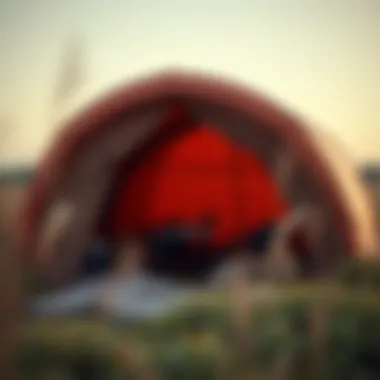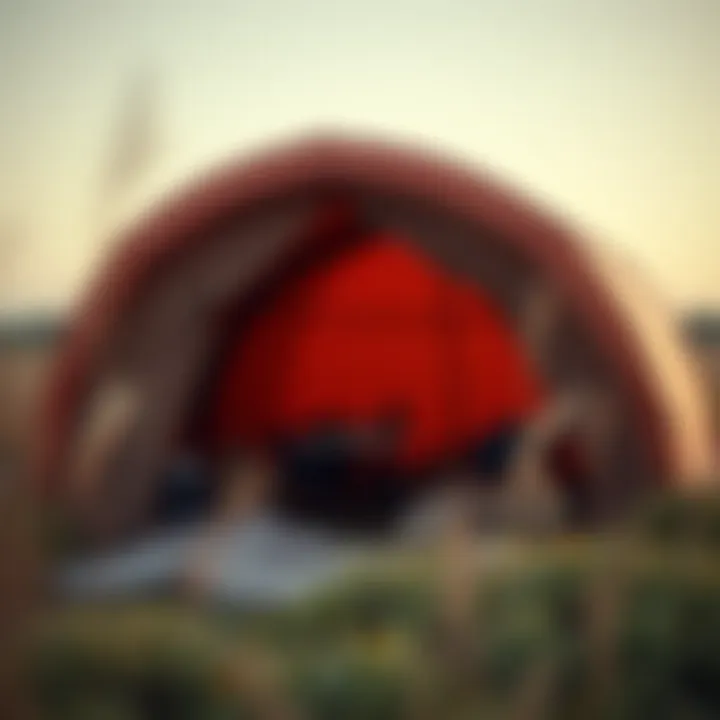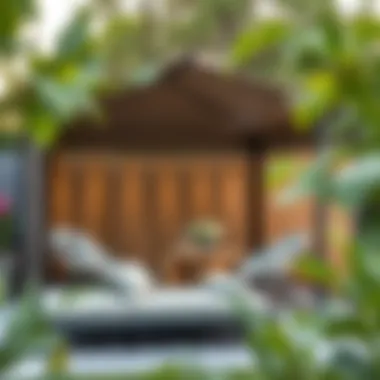Exploring Quick Pop-Up Shelters: Design and Utility


Intro
In today’s fast-paced world, adaptability and functionality are key elements in design, especially when it comes to shelter solutions. Quick pop-up shelters have emerged as a popular option, celebrated for their ease of setup and versatility. These structures can transform any temporary space into a cozy nook or a lifesaving haven in a pinch. Whether you're an outdoor enthusiast setting off for a weekend camping trip, a homeowner seeking innovative space solutions, or a designer looking for unique concepts, quick pop-up shelters have something to offer.
The beauty of these shelters lies in their straightforward construction and functionality. Imagine a rainy day at a music festival — a pop-up shelter can shield you from the downpour within minutes, all while maintaining your belongings dry and orderly. Similarly, during emergencies, such as natural disasters, these shelters can serve as vital support systems, providing safe spaces for those affected.
This exploration will take a deep dive into the various facets of quick pop-up shelters, from the materials that compose them, to their aesthetic appeal, and even to practical matters like space optimization in homes. By the end of this discussion, you’ll have a well-rounded view of how quick pop-up shelters blend functionality with style, making them a worthy consideration for anyone who values effective design.
Let’s set the stage by looking closely at the different factors involved in navigating this world.
Understanding Quick Pop-Up Shelters
Quick pop-up shelters have gained significant traction in various environments, from bustling outdoor festivals to unforeseen emergency situations. In this section, we will untangle the various threads weaving through the concept of these shelters. Understanding quick pop-up shelters means recognizing their multifaceted nature and how they contribute to a range of functionalities and user needs. The importance of this topic rests in its ability to illustrate not just the what's, but the why's and how's surrounding these versatile structures.
Definition and Purpose
A quick pop-up shelter can be termed as a temporary, easily assembled structure designed to provide immediate protection or space for various purposes. These are specially crafted to be set up in a matter of minutes, offering an accessible solution when time is of the essence. Their purpose often transcends mere functionality; it also includes delivering comfort and addressing safety needs in emergencies and recreational scenarios alike. In a world where the pace of life continues to quicken, having a convenient space in an instant feels like having a safety net on standby.
Historical Context
The roots of quick pop-up shelters can be traced back to the basic human need for shelter and protection. Historically, nomadic tribes utilized easily assembled and disassembled homes that could be transported as they moved. Urban evolution brought about truck-mounted tents deployed for concerts or fairs. During conflicts and natural disasters, organizations began leveraging the flexibility of these structures, paving the way for modern designs. This historical context gives perspective on how the need for immediacy and mobility has persisted through generations, making quick pop-up shelters more than just temporary solutions.
Categories of Quick Pop-Up Shelters
Different contexts demand different solutions, and as such, quick pop-up shelters can be classified into three main categories:
Emergency Shelters
Emergency shelters serve a vital role in disaster relief efforts, where human lives are at stake. Their key characteristic is rapid deployment, designed for swift setup in the aftermath of unforeseen events like floods or earthquakes. These shelters often come equipped with basic amenities to ensure safety and comfort in a crisis. A unique feature of these shelters is their minimalist design, prioritizing function over frills. While they are incredibly beneficial in providing shelter during emergencies, their durability can sometimes be a concern for lengthy use, which may limit comfort.
Camping Tents
Camping tents represent a more recreational side of quick shelters, designed for outdoor enthusiasts looking to explore nature without long setup times. Their defining characteristic is portability; they're made to fold into compact sizes, fitting snugly into backpacks. Many camping tents come with varied designs, which cater to different terrains and weather conditions. A unique feature lies in their ability to blend comfort with function, offering a decent sleeping space while maintaining lightweight assembly. However, some cheaper options may compromise on durability against extreme conditions.
Inflatable Structures
Inflatable structures have revolutionized the concept of quick shelters. They are characterized by their lightweight and ease of inflation, making them a playful yet practical choice for various events and even emergencies. The unique feature here is their ability to take shape through air, leading to innovative designs that can encompass not just tents but also large-scale event installations. However, while they can be incredibly space-efficient when stored, punctures can pose a significant risk to their integrity and usability down the line.
Key Advantages of Quick Pop-Up Shelters
The allure of quick pop-up shelters often rests on their practicality and ease of use. They come with a variety of benefits tailored to suit different needs, making them a favorite among campers, emergency responders, and event organizers alike. As we delve into the key advantages of these structures, it’s clear that their efficient design plays a monumental role in a world that values speed and convenience.
Rapid Deployment
One of the standout features of quick pop-up shelters is their ability to be set up swiftly. Unlike traditional tents that can feel like a Rubik's cube challenge in the midst of a windstorm, these shelters typically require only a few moments to assemble. For instance, some models can go from flat-packed to fully erect in under a minute, thanks to their innovative mechanisms.
This rapid deployment is not just a bonus; it’s a necessity in various scenarios. In emergency situations, such as natural disasters, there is often little time to waste. Being able to set up a shelter quickly can mean the difference between safety and exposure to the elements. Furthermore, outdoor enthusiasts appreciate this feature after a long day of hiking when they just want to kick back and enjoy the wilderness without the added stress of a lengthy setup process.
Portability and Storage
Portability is another crucial advantage to highlight. Most quick pop-up shelters are designed with the traveler in mind. They're lightweight and compact, making them easy to carry on a hike or store in the trunk of a car. Think about how cumbersome it can be lugging around bulky gear; these shelters eliminate that headache. Many models can collapse into a bag that is not much larger than a standard beach umbrella.
When it comes to storage, quick pop-up shelters shine as well. Whether you live in a cozy apartment or a larger suburban home, finding space for seasonal gear can be a chore. These shelters are made to tuck away neatly, taking up minimal room on a shelf or in a closet, making them a practical choice for anyone short on space.
Versatility in Use
The versatility of quick pop-up shelters is awe-inspiring. They are not limited to one function or setting. Emergency shelters, camping tents, and even inflatable structures can fall into this category, accommodating everything from outdoor gigs to festivals. This adaptability also means they attract a wide range of users, from hard-core adventurers hoping to escape into nature to families looking for an open-air picnic shade.
Adding to their versatility are the design options. Quick pop-up shelters often come with several feature enhancements like UV protection for sunny days and waterproof materials that ensure safety during unexpected rain showers. Because of their numerous applications, these shelters can be found in various contexts, fostering a sense of security and adaptability in environments that can be unpredictable.
"Quick pop-up shelters are like a Swiss Army knife for outdoor enthusiasts; they are compact, efficient, and ready for anything."
Disadvantages and Considerations
Understanding the drawbacks and considerations of quick pop-up shelters is crucial for anyone contemplating their use. While these shelters boast versatility and ease of setup, they are not without their challenges. Recognizing these issues can make the difference between a favorable experience and a frustrating one, especially in emergency situations, outdoor adventures, or temporary installations.


Durability Issues
Durability is often a key concern when it comes to quick pop-up shelters. Many products on the market rely on lightweight materials to achieve their easy assembly and portability. While this can be beneficial, it can also lead to questions about how long such structures will last under wear and tear.
For instance, think of that inflatable shelter you set up for a weekend camping trip. It might hold up well during clear skies, but a sudden gust of wind could have the potential to pop or damage it if it’s not secured properly. Frequent usage can wear down the fabric over time, especially in high-traffic areas like entrances.
Furthermore, unlike conventional tents which may have reinforced seams and higher-quality materials, some quick pop-up shelters may cut corners to remain cost-efficient. Therefore, when selecting a shelter, it’s important to scrutinize the warranty and craftsmanship to ensure you’re making an informed decision.
Weather Resistance
Another not-so-glamorous aspect of quick pop-up shelters is their ability to withstand varying weather conditions. Many designs may not offer the same level of weatherproofing compared to more traditional, heavier tents or permanent structures.
Imagine you are in the midst of a summer downpour. If your pop-up shelter is not adequately resistant, you might find yourself swamped with water pooling in the corners. Many pop-up options lack the resilience of thicker fabrics that provide effective waterproofing.
Aside from rain, let’s not forget about wind and UV rays. A less robust shelter could buckle under strong winds, or the fabric might degrade over time when exposed to harsh sunlight. It's advisable to consider environments in which you plan to use the shelter and choose one designed to withstand those conditions.
Comfort Concerns
Comfort can greatly affect the usability of quick pop-up shelters. Often, they are designed more for functionality than for user comfort. For instance, the interior space can vary significantly, and some models may lack headroom or adequate ventilation.
Picture yourself camping under a dome that's barely taller than a coffee table. Struggling to sit up straight can quickly take the fun out of a relaxing retreat in nature. Moreover, in hot weather, inadequate airflow can create a stuffy atmosphere, leaving occupants feeling claustrophobic and irritated.
"Choosing the right quick pop-up shelter can dictate how enjoyable your experience is, whether it be a camping trip or an impromptu gathering. Think through your needs."
In summary, while quick pop-up shelters carry significant advantages in terms of convenience and accessibility, it is essential to weigh these alongside their disadvantages. Taking durability, weather resistance, and comfort into account will help you make a well-rounded decision that meets your specific needs.
Materials Used in Quick Pop-Up Shelters
The choice of materials in quick pop-up shelters is not just a matter of preference; it's crucial for defining the shelter's overall efficacy and longevity. This section underlines how various materials contribute to the performance, style, and practicality of these structures.
Fabric Types
Nylon
Nylon stands out as a common choice for pop-up shelters due to its lightweight nature and resilience. The fabric is known for its high tensile strength, meaning it can endure stress without falling apart easily. Many users appreciate nylon tents because they pack down small, making them easy to transport.
A unique feature of nylon is its water resistance. When treated correctly, this fabric sheds water effectively, adding an extra layer of protection in rainy conditions. However, it also has its downsides; being less breathable can lead to condensation inside, making it uncomfortable for extended use in humid environments.
Polyester
Polyester is another popular fabric for pop-up shelters, often chosen for its affordability and durability. It generally resists fading and holds its shape better than some alternatives. The quick-drying nature of polyester is a significant advantage—no one wants a soggy shelter after a brief rain shower.
A notable feature of polyester is that it can be treated to enhance water resistance, allowing for additional longevity. On the flip side, polyester does tend to be heavier than nylon, which may influence portability for some users. Nevertheless, its balance of price and function makes it appealing for various scenarios.
Canvas
Canvas is a timeless fabric, often associated with durability and a classic aesthetic. This material is thicker than both nylon and polyester, providing ample insulation and protection against the elements. One of its key characteristics is breathability, allowing for air circulation in warm conditions, which can enhance user comfort.
However, canvas does come with its own challenges. It is heavier and bulkier compared to its synthetic counterparts, possibly making transportation a hassle. Additionally, canvas can absorb water, requiring regular maintenance and treatment to maintain its water-resistant properties. Despite these drawbacks, its robustness makes it an ideal choice for prolonged use in fixed situations.
Structural Frameworks
Fiberglass Poles
Fiberglass poles are often utilized in quick pop-up shelters for their lightweight properties and resistance to rust. This material offers a combination of flexibility and strength, making it a stable choice when properly tensioned. Fiberglass is also relatively inexpensive and easy to replace, providing cost-effectiveness for manufacturers.
However, there are things to consider with fiberglass; the poles can become brittle over time, especially when exposed to repetitive stress or extreme conditions.
Aluminum Frameworks
Aluminum frameworks represent an upgrade in durability and strength. Lightweight yet sturdy, aluminum is perfect for quick setups and takedowns, which is at the heart of pop-up shelter design. Users benefit from its resistance to corrosion, making it a great option for various environments.
Though aluminum is more expensive than fiberglass, many find its long-term benefits outweigh the initial investment. Still, it’s worth noting that in extreme cold, aluminum can become brittle, which may present issues in specific circumstances.
Inflatable Beams


Inflatable beams are a modern innovation in quick pop-up shelters, allowing for an entirely different way to achieve structure and stability. These beams provide excellent insulation and often reduce the overall weight of the shelter. They also enable faster setup times—just inflate and you're good to go.
The primary advantage of inflatable beams lies in their shock-absorbent nature, which can withstand impacts better than traditional poles. On the downside, punctures can be a real headache. Proper care is needed to avoid damage, making users a bit more cautious.
In considering materials and frameworks, it's important to align them with the specific uses of the shelter—whether for a weekend camping trip or emergency disaster relief. Ultimately, the blend of fabric and structural elements should provide not only shelter but also comfort and ease.
Design Trends in Quick Pop-Up Shelters
Understanding the evolution of design trends in quick pop-up shelters is essential for grasping how they fit into modern spaces and meet diverse needs. As these shelters continue to gain popularity, designers are keen on integrating practical elements with visual appeal, enhancing functionality while adhering to current consumer expectations. In this section, we’ll delve into three critical aspects: modern aesthetic considerations, innovations in colors and patterns, and the use of eco-friendly materials.
Modern Aesthetic Considerations
The visual appeal of quick pop-up shelters has changed significantly over the years, shifting from the utilitarian look of early designs to more contemporary forms that emphasize style and sophistication. Today's consumers prefer shelters that complement their outdoor or event settings rather than detracting from them. Designers are making a conscious effort to blend shelters seamlessly into the environment, using minimalist shapes or organic forms that evoke a sense of harmony with nature.
This aesthetic emphasis doesn't just satisfy the eye; it also reflects changing cultural values, where both functionality and form are paramount. For instance, sleek lines and understated details contribute to an elegant look, appealing to upscale markets. An example of this trend can be seen in the elegant curves of the Tentsile Stingray, which offers a futuristic look while remaining practical.
Color and Pattern Innovations
Color and pattern have emerged as pivotal elements in the design of quick pop-up shelters. Gone are the days of bland, monotonous colors. Today's designs feature vibrant hues and unique prints that not only grab attention but also serve practical purposes such as camouflage in natural surroundings. Bright colors can enhance visibility, a crucial factor during emergencies or outdoor adventures.
Innovative digital printing techniques allow for intricate patterns that can cater to individual tastes or promote brands. For example, companies like Quechua have experimented with nature-inspired designs, such as leaf patterns, which resonate with their target audience of nature lovers. More than just decoration, these designs create a sense of personal expression for users, making each shelter feel bespoke.
Eco-Friendly Materials
As sustainability becomes a central concern for consumers and designers alike, the choice of materials for quick pop-up shelters has transformed. Modern designers prioritize eco-friendly materials not only to mitigate environmental impact but also to cater to a growing market that values sustainable practices. Materials such as recycled polyester or organic cotton are gaining traction.
"Using eco-friendly materials not only reduces the carbon footprint but also sets a brand apart in a competitive market."
Incorporating biodegradable plastics and natural fibers exemplifies a commitment to environmental stewardship. Brands such as Big Agnes are already taking the leap by offering tents constructed from recycled materials, striking a chord with environmentally conscious customers. Moreover, this trend promises future innovations as technology progresses, potentially leading to fully biodegradable quick pop-up shelters in the coming years.
Applications in Various Contexts
The utility of quick pop-up shelters transcends their initial perception as mere temporary structures. In this segment, we dive into the multifaceted applications of these shelters, exploring how they serve critical roles in emergency situations, outdoor leisure, and temporary gatherings. The flexibility and function of quick pop-up shelters make them ideal solutions in a variety of scenarios.
Emergency Disaster Relief
In times of crisis like natural disasters, the immediacy of shelter provision is crucial. Quick pop-up shelters can be deployed rapidly in areas struck by calamities such as hurricanes, floods, or earthquakes. These shelters provide a level of safety and security for displaced individuals, offering protection against the elements while more permanent housing solutions are being arranged.
The real beauty of these shelters lies in their mobility. When emergencies strike, logistics become a nightmare, but having lightweight and easy-to-move structures can expedite the relief process. Organizations, including the Red Cross, have increasingly turned to pop-up designs for their operations. A shelter that can be set up in under 15 minutes can make a significant difference when resources and time are at a premium.
- Key Considerations:
- Location Accessibility: The shelters need to be easily transported to and from affected areas.
- Rugged Design: Durability against harsh weather improves survivability.
- Capacity Flexibility: These shelters should accommodate varying numbers of occupants depending on circumstances, ensuring no one is left out in the cold—literally.
"A rapid response can be the line between life and death in disaster scenarios. Quick shelters offer an immediate haven when hope is most crucial."
Outdoor Recreational Use
The outdoor lifestyle has seen a rise in popularity, leading to the growth of quick pop-up shelters in recreational activities. From camping trips to beach vacations, these structures have found their niche among adventurers and leisure seekers alike. They offer an exceptional balance of portability and protection, making it much easier to enjoy nature without the hassle of traditional tents.
Imagine setting out for a weekend camping trip. You lug your gear to the campsite, but rather than spending half an hour wrestling with poles and fabric, you have a pop-up tent that springs into shape in seconds. This ease of setup means more time savored around the campfire, sharing stories under the stars.
- Benefits:
- Quick Setup: Less time setting up means more enjoyment.
- Weather-Resistant Materials: Modern advancements ensure that unexpected rain won't turn your trip into a soggy affair.
- Versatility: With options suitable for both family outings and solo adventures, these shelters cater to various preferences.
Event Hosting and Temporary Installations
Events, whether personal or community-driven, often need flexible space solutions. Quick pop-up shelters serve as the go-to solution for many who are planning outdoor events, such as festivals, fairs, and gatherings. These tents not only provide shelter from sun or rain but also can be styled to enhance the aesthetic experience of the event.
A wedding on a picturesque hillside? An outdoor corporate event? The ability to quickly assemble and dismantle these shelters allows planners to focus on their vision rather than logistical challenges. Colors, patterns, and layouts can be adjusted to fit the event’s theme, marrying functionality with style.
- Important Points:
- Customizability: Easily decorate these shelters to align with the event’s theme.
- Space Management: Utilize multiple structures to create distinct spaces for activities.
- Cost-Effectiveness: These units present an economical choice compared to more permanent structures, especially for one-off occasions.


As we embark on an exploration of installation and maintenance next, we will dissect the steps to ensure that those who invest in these shelters can maximize their lifespan and usability.
Installation and Maintenance
When it comes to quick pop-up shelters, understanding the installation and maintenance process is vital. This is not just about setting up a shelter; it's about ensuring that you maximize its lifespan, functionality, and aesthetic appeal. Proper installation contributes significantly to the overall user experience, while diligent maintenance ensures that the shelter remains reliable and in good condition for repeated use.
Setup Process
The setup process for quick pop-up shelters can vary by design but generally follows a straightforward pattern. First and foremost, before any shelter is deployed, it's crucial to choose the right location. Ideally, you want a level area free from debris that could damage the shelter's base or fabric.
- Unpack the Shelter: Open the carrying bag and lay the shelter flat on the ground, ensuring all components are visible.
- Extend the Framework: Many quick pop-up structures feature a hub system. Gently pull apart the sections until you feel a click that signifies the frame is locked in place. This can be a tricky maneuver, especially if it’s windy, so having an extra set of hands can be helpful.
- Attach the Fabric: Once the frame is up, drape the fabric over the structure, ensuring that it aligns with the frame. Secure any buckles or clips according to the manufacturer's instructions.
- Stake and Weigh Down: To prevent the shelter from lifting in winds or shifting, stake it down if the ground allows. If staking isn't an option, using weights or sandbags can provide the necessary ballast to keep the shelter firmly in place.
- Final Checks: Ensure all zippers function properly and that there are no tears or weak points in the fabric. A quick visual inspection could save a lot of hassle down the line.
Following these steps not only simplifies the setup process but enhances the shelter’s stability and safety. The quicker and easier the setup, the more time you can spend enjoying the outdoors or focusing on whatever event you are hosting.
Proper Care and Storage
Just as important as setting up a pop-up shelter properly is taking the time for its care and storage once you've finished using it. Here's where many users may slip up; they often neglect the post-use maintenance, leading to diminished performance over time.
- Clean Regularly: After each use, give your shelter a good cleaning. Use a mild soap and water to wash the fabric, taking care to pay special attention to any stubborn stains. Avoid harsh chemicals that could degrade the materials.
- Dry Completely: Before folding up the shelter, make sure it’s completely dry to prevent mildew and mold. If you've set it up in the rain, it’s worth the effort to let it air dry thoroughly before packing.
- Storage Conditions: Store the tent in a cool, dry place away from direct sunlight. Excessive heat and sunlight can weaken the materials over time. Use the original carrying bag or a breathable fabric bag to protect it from dust and pests.
- Annual Checks: At least once a year, do a thorough inspection of the shelter. Check for any signs of wear and tear, replacing essential components like stakes or poles if necessary. Regular maintenance checks can help catch small issues before they become big problems.
"A little care goes a long way in prolonging the life of your quick pop-up shelter, ensuring it’s ready when you are!"
Understanding the ins and outs of installation and maintenance allows you to invest wisely in quick pop-up shelters, getting the most out of your purchase while keeping your stress levels low when it's time to set up or pack away. Being proactive in these aspects is what separates a good experience from a less than ideal one.
Future of Quick Pop-Up Shelters
Understanding the trajectory of quick pop-up shelters is crucial for anyone involved in design, retail, or even emergency management. These structures have rapidly evolved, addressing both practical and aesthetic needs. Knowing where they are headed can provide insights for designers, retailers, and homeowners looking to invest wisely.
Technological Advancements
Technological improvements are reshaping the landscape of quick pop-up shelters. Innovations in materials, like ripstop nylon and advanced polyester blends, are making these shelters not just lighter but also more durable. Imagine a tent that can withstand strong winds and heavy rain while remaining easy to set up.
Recent advancements include:
- Smart Technology Integration: Some new pop-up shelters are now incorporating solar panels to power small devices, making life more convenient even when you're off the grid.
- Enhanced Weather Features: Sophisticated waterproofing techniques, combined with thermal insulation, keep users safe and comfortable regardless of the conditions outside.
Furthermore, the rise of 3D printing is changing production methods. This technology allows for customized designs at a fraction of the time and cost, enabling unique, client-specific solutions.
"The future lies not in traditional approaches but in embracing technology to enhance experience and functionality," says a renowned designer in the field.
As we venture further into the age of sustainability, one can expect new eco-friendly materials to also be integrated. This trend hasn’t just become a preference but a necessity for conscientious consumers.
Market Trends
The market for quick pop-up shelters is poised for growth. Various factors contribute to this, ranging from social changes to environmental conditions. It's essential to keep an eye on these trends for those invested in the sector.
Current market trends include:
- Increased Demand for Multi-Functional Spaces: People are looking for versatile solutions that can be used both indoors and outdoors, such as pop-up offices or leisure spaces.
- Focus on Sustainable Options: Eco-conscious consumers are favoring shelters made from recycled materials, which lowers the carbon footprint and fits with sustainable living lifestyles.
- Customization: More consumers are finding that off-the-shelf options don't always meet their needs. Tailored solutions are gaining traction, allowing customers to choose colors, designs, and additional features.
Observing these trends not only aids in understanding the product's life cycle but also helps stakeholders prepare for the shifts in consumer preferences. In this ever-evolving market, adaptability will be a key strategy for success. Knowing where to pivot can either align a business with future demands or leave it trailing behind.
By keeping these technological advancements and market trends in mind, designers, retailers, and all involved in the ecosystem of quick pop-up shelters can effectively strategize and innovate. The future looks promising, but it requires proactive engagement with the tools and trends shaping it.
The End
The exploration of quick pop-up shelters illuminates a growing need for flexible, practical solutions in today’s ever-evolving environments. These structures, designed for swift assembly and disassembly, embody a perfect merger of utility and design, serving diverse needs across various contexts.
Key Elements of Quick Pop-Up Shelters
- Adaptability: From emergency situations such as natural disasters to leisurely family camping trips, these shelters can morph to fit a wide array of needs, highlighting their versatility.
- Convenience: The ease of setup eliminates the headache often associated with traditional tents or temporary housing, which makes them ideal for spontaneous adventures or necessary relief situations.
- Cost-Effectiveness: Utilizing readily available materials and simple designs, quick pop-up shelters can be produced economically, making them accessible to both individual consumers and organizations providing disaster relief.
Benefits and Design Considerations
When appreciating the benefits, one must also consider potential drawbacks such as durability and weather resistance. The life span of these shelters often hinges on the choice of materials and their intended use. Safeguarding against extreme weather conditions remains a critical factor in their design, often calling for continued innovation in fabric technology.
It’s also worth highlighting the aesthetic contributions that modern designs offer. Quick pop-up shelters are no longer just functional eyesores; they can enhance an outdoor experience or temporary installation with engaging colors and patterns.
In retrospect, the ability to swiftly provide shelter—whether for recreation, relief, or event hosting—underlines the profound relevance of quick pop-up shelters in addressing contemporary issues faced by diverse audiences, from homeowners to event planners. As technology advances, we can expect to see even more innovative designs that will further enhance the experience and effectiveness of these structures.
"The true measure of a shelter's success lies not just in its structure, but in how well it adapts to the needs of those relying on it."
The road ahead for quick pop-up shelters looks promising, and as we adapt to new challenges, these shelters will undoubtedly prove to be a resourceful solution—merging practicality with design in a seamless fashion.







